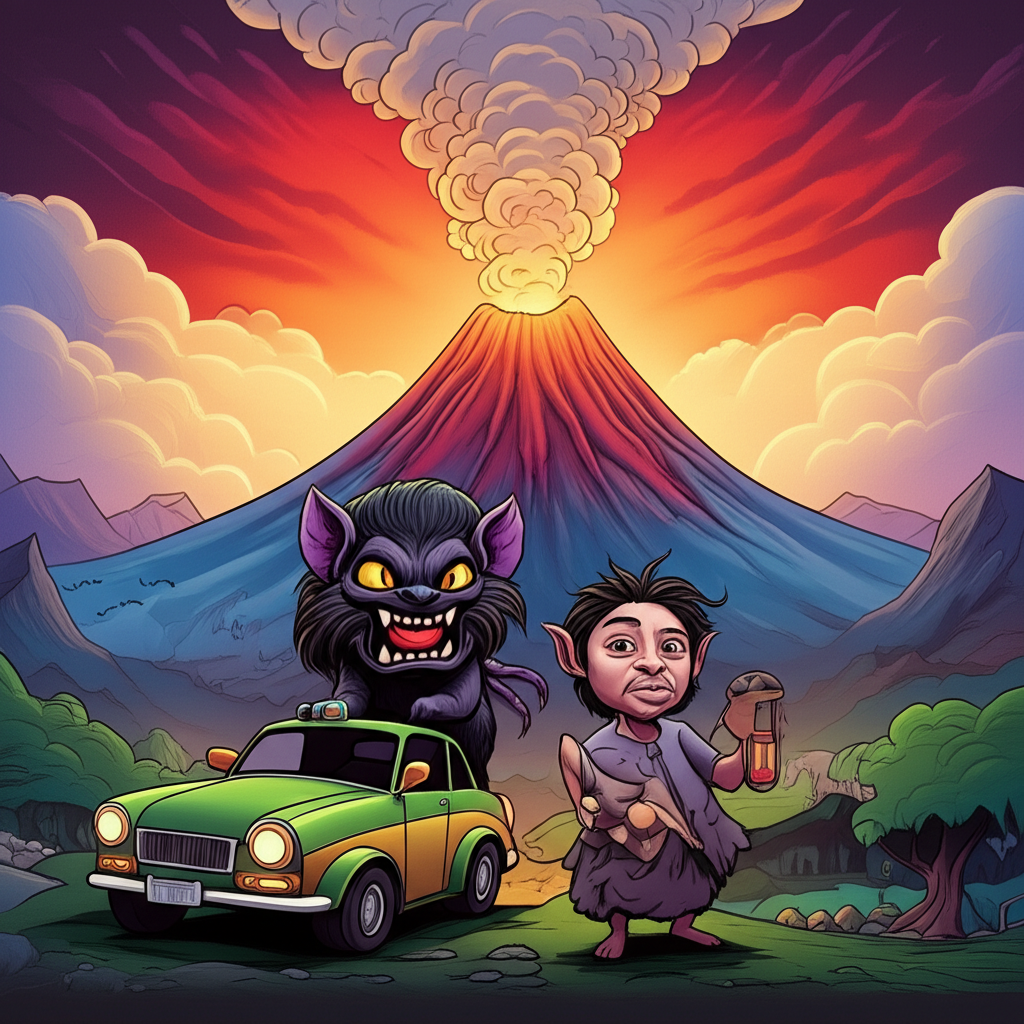
Disclaimer: This article explores a mythological tale from the Philippines for cultural, historical, and educational understanding. The story and the figures within it are part of a rich tradition of folklore and are not intended to be regarded as factual or for any form of worship.
Introduction
From the verdant, volcanic islands of the Philippine archipelago comes a vast and intricate tapestry of folklore, woven through generations by the spoken word. Among these ancient narratives are the creation myths of the Tagalog people, the inhabitants of the central and southern regions of Luzon. These stories, born from a time long before recorded history, were not just entertainment; they were the lens through which early Filipinos understood their world. They were attempts to answer the most profound questions: Where did we come from? Why does the sea rage? How were our thousand islands formed? Central to some of these powerful, elemental tales is the figure of Amanikable, the temperamental ruler of the sea, whose story is less about deliberate creation and more about the chaotic, beautiful shaping of the world through conflict and passion. This is a traditional story, a product of human imagination seeking to find order in the awesome power of nature.
Origins and Cultural Background
To understand the story of Amanikable, one must journey back in time to a pre-colonial Philippines. This was an era where life was deeply intertwined with the natural world. The ancient Tagalogs lived in a society organized into barangays, coastal or riverine communities whose survival depended on the bounty of the land and, most importantly, the sea. Their worldview was animistic; they believed that the world was alive with spirits, or anito. Trees, mountains, rivers, and animals all possessed a spiritual essence. The sky was not just an empty expanse, and the sea was not merely a body of water. They were living, breathing entities with consciousness and will.
In this environment, the sea was both a giver and a taker. It provided fish for sustenance and served as the highway for trade and travel. But it also brought devastating typhoons, unpredictable currents, and terrifying tsunamis that could wipe out a coastal village in an instant. It was this dual nature—the serene, life-giving provider and the wrathful, destructive force—that ancient storytellers sought to explain. They did so by personifying it, giving it a name, a face, and a temperament. This personification was Amanikable, a being whose moods could explain the inexplicable and unpredictable nature of the ocean.
Character Description: The Spirit of the Ocean
Amanikable is often depicted in folklore as an ancient, powerful, and notoriously ill-tempered being. He was not a creator in the same vein as a supreme, all-knowing deity, but rather a primordial force who ruled his domain with an iron fist. Descriptions imagine him as a rugged, imposing figure, his skin as coarse as coral and his long hair like tangled seaweed, adorned with pearls and shells from the deepest trenches. His voice was said to be the roar of the surf, and his anger, the fury of a typhoon.
Symbolically, Amanikable represents the untamable and sovereign power of the natural world. He is the embodiment of the ocean’s raw energy. His treasures—the fish, the pearls, the coral reefs—were seen as his gifts, bestowed upon those who showed respect. His rage—the storms and giant waves—was the consequence of disrespect or simply the result of his own volatile nature. He was not inherently evil, but rather amoral and elemental, much like nature itself. To the ancient Tagalogs, he was a reminder that humanity was a small part of a much larger, more powerful world, and that survival depended on understanding and respecting the forces that governed it.
Main Story: The Shaping of the Isles
In the time before time, as the old tales go, there was only the vast expanse of the sky, known as Kaluwalhatian, and the endless, deep sea, called Karagatan. A supreme being, Bathala, was said to exist in a state of eternal contemplation, but the world as we know it was unformed. The Sky and the Sea existed in a tense, silent standoff. The ruler of this boundless ocean was the restless Amanikable.
For eons, Amanikable grew weary of the stillness. He saw the Sky as a placid, arrogant rival, always looking down upon his watery kingdom. One day, driven by boredom and a surge of pride, Amanikable decided to challenge the Sky’s dominance. He summoned the deepest waters of the ocean and hurled colossal waves, thousands of feet high, into the heavens. The Sky, startled and angered by this assault, fought back. It began to rain down giant rocks, boulders of earth, and molten fire upon the sea.
What followed was a cataclysmic battle that raged for centuries. Amanikable’s waves crashed against the sky, trying to drown it, while the Sky’s rocky projectiles plunged into the ocean, trying to fill it. The world was a maelstrom of steam, water, and stone. Amanikable, in his fury, did not realize that his destructive actions were, in fact, an act of shaping.
The massive rocks thrown by the Sky did not sink into the abyss but settled on the ocean floor, piling on top of one another until their peaks broke the surface of the water. These became the first islands. The relentless pounding of Amanikable’s waves carved their coastlines, creating jagged cliffs, gentle coves, and sandy beaches. The deep gouges left in the seabed from the Sky’s assault became the ocean’s mysterious trenches.
After the fury of their battle subsided, a new world had been formed—a scattered archipelago of thousands of islands, cradled by the now-chastened sea. The war had exhausted both realms. It was in this newfound quiet that a third elemental being, the wind in the form of a great bird named Amihan, began to fly between the weary Sky and the calmer Sea. One day, Amihan landed on a stalk of bamboo that had grown on one of the new islands. As it pecked at the bamboo, the stalk split open, and from it emerged the first man, Malakas (The Strong), and the first woman, Maganda (The Beautiful).
Amanikable had not intended to create the land for humanity, but his primordial rage had inadvertently forged the stage upon which their story would begin. He remained the ruler of the seas, a constant, powerful presence whose temper still flared from time to time, reminding the island dwellers of the chaotic origins of their home.
Symbolism and Meaning
This narrative served as a powerful explanatory tool for the ancient Tagalogs. The story of Amanikable’s battle with the sky is a profound metaphor for the region’s volatile weather, particularly the typhoons that form over the ocean and batter the land. The clash of water and sky in the myth perfectly mirrors the real-world clash of wind and sea during a storm.
Furthermore, the myth explains the very geography of the Philippines. Why is it an archipelago and not a single landmass? The story provides a dramatic answer: the islands are the remnants of a cosmic war. This transformed a simple geographical fact into a tale of epic significance. On a deeper level, the story taught a lesson of respect and humility. Amanikable symbolized the idea that nature’s most powerful forces are beyond human control. The only appropriate response was to respect the sea, to learn its rhythms, and to appease its spirit through offerings and reverence, not out of worship, but out of a practical need for survival.
Modern Perspective
Today, the figure of Amanikable and the creation myths of the Tagalogs are no longer used to explain natural phenomena. Science has provided different answers. However, these stories have found a new life as vital pieces of cultural heritage. They are studied in universities as examples of pre-colonial literature and belief systems. Filipino writers and artists draw inspiration from these myths, re-imagining Amanikable and other mythological figures in modern novels, graphic novels, films, and video games. In these new forms, he is often portrayed as a complex character—a fierce protector of marine life, a tragic figure of lost love, or a formidable antagonist. This cultural revival helps modern Filipinos connect with their indigenous roots and appreciate the rich, imaginative traditions of their ancestors.
Conclusion
The tale of Amanikable is a powerful testament to the storytelling traditions of the Tagalog people. It is a cultural artifact, a window into how an ancient society made sense of its environment through imaginative and dramatic narrative. These myths should be understood not as literal truths to be believed, but as symbolic stories that carry the wisdom, fears, and cultural identity of a people.
As Muslims, we firmly recognize that only Allah is the one true Creator and Sustainer of the heavens and the earth, and all that is within them. The act of creation belongs to Him alone.
Folktales like that of Amanikable, however, remain valuable. They remind us of the universal human impulse to tell stories, to find meaning in the world around us, and to preserve our heritage through the enduring power of imagination. They are not a challenge to faith, but a celebration of culture, history, and the timeless art of the story.





